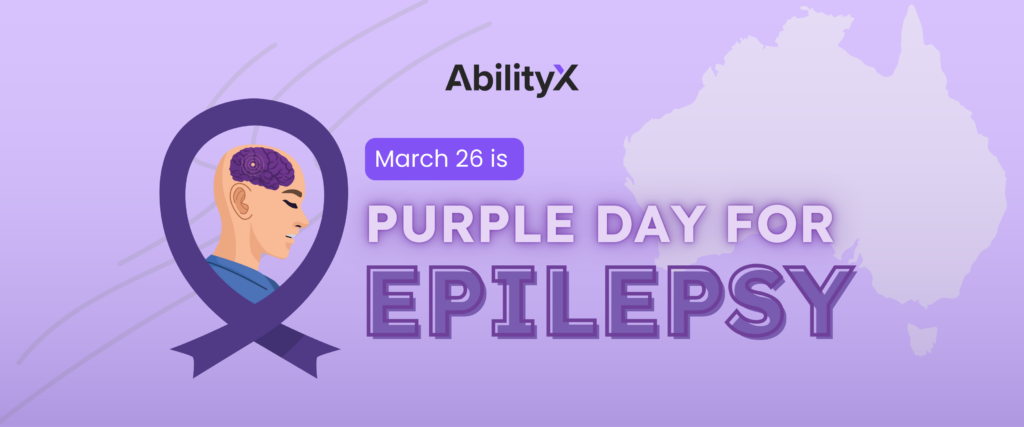Across Australia, communities are gearing up for a month-long campaign to raise awareness about a neurological condition affecting millions globally – epilepsy. Every March 26th marks Purple Day, a global initiative serving as a crucial platform for education and understanding.
The impact of epilepsy in Australia is stark. Every 33 minutes, someone’s life is upended by a diagnosis. This chronic condition, characterised by recurrent seizures, can have a profound ripple effect, impacting not just the individual but also their families, affecting employment, education, and overall well-being.
What is Epilepsy?
The World Health Organization defines Epilepsy as a chronic noncommunicable disease of the brain that affects around 50 million people worldwide.
For Australians, epilepsy is closer to home, impacting roughly 3 in every 100 citizens. These seizures, often referred to as “fits,” are brief episodes triggered by surges of electrical activity within the brain. They can manifest as involuntary movements, affecting either a specific area (partial seizure) or the entire body (generalised seizure). In some cases, loss of consciousness and loss of bowel or bladder control may accompany the seizure.
Then there are also absence seizures, which cause a vacant stare and may be mistaken for a brief lapse in attention. These seizures typically last about 10 seconds, though they may last as long as 30 seconds. Absence seizures most commonly occur in children and can sometimes lessen or disappear as they get older.
It’s important to distinguish a single seizure from epilepsy. A diagnosis of epilepsy requires experiencing at least two unprovoked seizures – meaning they occur without a clear cause – separated by at least 24 hours. Epilepsy isn’t a singular condition; various factors can contribute to seizures.
Thankfully, treatment options exist. Medications and, in some cases, surgery can effectively control seizures for most people with epilepsy. While some require lifelong treatment, others experience complete remission, with seizures disappearing altogether. For children with epilepsy, there’s even a chance of outgrowing the condition entirely.
By understanding epilepsy, we can dismantle stigmas and empower individuals living with this condition. With proper treatment and support, people with epilepsy can lead fulfilling lives.
Epilepsy Signs, Symptoms, and Causes
Epilepsy manifests through a spectrum of symptoms, fundamentally linked to abnormal brain activity leading to seizures. These seizures vary greatly, from brief lapses in attention to severe convulsions.
Beyond the physical impact, epilepsy often brings with it significant psychological and social challenges. Concerns about unpredictable seizures can limit independence, fostering anxiety about potential injury during a seizure or due to a misinformed public reaction. These factors can contribute to heightened rates of anxiety and depression compared to the general population.
The causes of epilepsy are diverse, with genetics, head trauma, brain conditions, infections, prenatal injury, and developmental disorders all playing potential roles.
Empowering Communities: The Heart of Epilepsy Support
The Make March Purple campaign transcends Purple Day itself, igniting conversations throughout the month to challenge the stigma surrounding epilepsy. Community involvement is crucial, with numerous Australian epilepsy organisations spearheading initiatives to promote awareness and support.
Here are some key organisations focusing on epilepsy support in Australia:
- Epilepsy Action Australia (www.epilepsyaction.com.au) – focuses on providing comprehensive support through education, advocacy, and direct services to individuals with epilepsy nationwide, aiming to enhance quality of life and community understanding.
- Epilepsy Foundation (www.epilepsyfoundation.org.au) – dedicates itself to reducing epilepsy’s impact through research, advocacy, and education, striving for improved wellbeing and community awareness.
- Epilepsy ACT (www.epilepsyact.org.au) – offers targeted support within the Australian Capital Territory, emphasising education, support services, and advocacy to foster a better understanding and inclusive environment for those with epilepsy.
- The Epilepsy Centre (www.epilepsycentre.org.au) – since 1976, this organisation has excelled as the primary provider of epilepsy services in South Australia and the Northern Territory, offering superior support, counselling, training, and advocacy, while tirelessly working to enhance epilepsy awareness and inclusivity.
- National Disability Insurance Scheme (www.ndis.gov.au) – offers a broader scope of support, including funding and services for Australians with disabilities, including those with epilepsy, to promote independence and participation in the community.
Beyond National Organisations: Local Support and Resources
Initiatives like Epilepsy Smart Schools aim to transform Australian schools into supportive environments for students with epilepsy through awareness programs, staff training, and inclusive policies.
Moreover, community-based organisations like Epilepsy Queensland, Epilepsy WA, and Epilepsy Tasmania provide localised support, education, and advocacy to improve the lives of those affected by epilepsy in their respective regions.
There are also platforms available like AbilityX, a comprehensive resource for individuals with disabilities. AbilityX connects users with a wide range of services, support programs, and community initiatives. They focus on empowering users by providing accessible information and facilitating engagement with essential services tailored to their unique needs, thus enhancing their independence and quality of life.
Does the NDIS provide support for Epilepsy?
The NDIS is a government-funded program supporting Australians with disabilities, including those with epilepsy. It connects individuals with services and empowers them to set goals for a more independent life. Each person receiving NDIS funding creates a personalised plan outlining their goals and the support required to achieve them.
To determine if you’re eligible for NDIS support, you’ll need to provide information about your epilepsy, including its duration, current treatment regime, and any other impairments you may have. Your healthcare providers can help assemble supporting documentation for your application. This typically includes assessments like the Care and Need Scale (CANS), which evaluates the functional impact of your condition on mobility, communication, social interaction, and your need for assistive technology.
The NDIS eligibility criteria include:
- Being aged between 9 and 64 years old.
- Holding Australian citizenship, permanent residency, or a protected special category visa.
- Having a permanent and significant disability that impacts daily activities.
- Requiring support or specialised equipment due to your disability.
It’s important to note that NDIS support is available for Australians who are under 65 years old at the time of their application. For children under 9, Early Childhood Early Intervention (ECEI) support is available, designed to cater to younger children with developmental delays or disabilities. Applicants need to submit their NDIS application before their 65th birthday to be considered for the scheme. Individuals who become NDIS participants before turning 65 can continue to receive NDIS support even after they turn 65, based on their preferences and needs.
When applying for assistance through the NDIS, you need to provide supporting documentation on how the condition impacts daily activities. You can check your eligibility using the NDIS checklist on their website.
Epilepsy affects people differently. Your epilepsy may not have a big impact on your life. You may be able to manage your epilepsy with medication and services provided through the health system. Or your epilepsy may have a big impact on your life. It may affect your education, employment, lifestyle, health, social and family life.
The NDIS may fund support to help people with epilepsy manage their condition if their disability means they can’t do things on their own. The support might be assistive technology, for example alarms or seizure monitor; or a support worker or nurse to monitor your seizures.
Epilepsy supports are one of the disability-related health supports NDIS may fund. Learn more about other disability-related health supports.
NDIS-Funded Supports for Epilepsy
The NDIS can fund various support services to help you manage your epilepsy effectively. Here are some key examples:
- Monitoring an Epilepsy Management Plan (EMP) – This plan details your seizure types, triggers, preferred support during a seizure, and emergency procedures. The NDIS can fund a qualified worker to help implement and monitor this plan, ensuring everyone around you knows how to respond effectively in case of a seizure.
- Emergency Medication Management Plan (EMMP) – This plan outlines your epilepsy medication, dosage, administration method, and emergency procedures. Similar to the EMP, the NDIS can help fund a nurse or support worker to monitor seizures and execute an epilepsy management plan, ensuring safety and effective response during emergencies.
- Seizure Monitoring – Depending on your individual needs, the NDIS may fund seizure monitoring through support workers or nurses in specific cases.
- Support Worker Training – The NDIS can fund training for support workers to ensure they have the necessary skills to assist participants with epilepsy effectively. This is especially important if the participant’s NDIS plan includes an EMP, EMMP, or requires adherence to a specific diet that helps in managing epilepsy.
- Assistive Technology – The NDIS can help cover the cost of assistive technologies for seizure monitoring, such as wearable devices, bed sensors, video monitors, and personal alarms.
- Support Worker Assistance – The NDIS may also provide funding for support workers to assist with daily living activities. This can include help within the home, such as personal care, assistance with community participation and activities outside the home, like travel, food shopping, and meal preparation. This support is aimed at ensuring safety and promoting independence and inclusion for those with epilepsy.
How to Apply for NDIS Support
If you believe you meet the NDIS eligibility criteria, here’s how to get started:
- Call the NDIS on 1800 800 110 and ask to make an access request.
- Complete and submit the Access Request Form by email to [email protected].
- Contact your Local Area Coordinator or National Disability Insurance Agency (NDIA) office.
If you have a child under 9, an early childhood partner can provide advice on access to support and apply for the NDIS. As part of the application process, you will be asked:
- To confirm your identity and authority to act on someone’s behalf
- Questions to see if you meet the NDIS access requirements: age, residence, and disability.
- Questions about providing consent to enter the NDIS and seeking information from third parties.
It’s important to note that the NDIS goes beyond just financial support. They can also connect you with valuable community resources like doctors, support groups, schools, and sporting clubs – all crucial aspects of managing epilepsy effectively.
Creating a Better Future, Together
Making March 26 of every year Purple Day is more than just a commemoration but a stride forward in creating a more informed and supportive environment for Australians living with epilepsy. By working together, we can raise awareness, dismantle stigma, and ensure everyone with epilepsy can thrive. Let’s make a difference.






 James
James 

